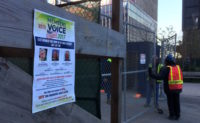New York contractors and developers are jumping into the high-stakes debate over how to solve the state’s chronic housing shortage. In a report released earlier this month, the New York Building Congress proposes changes aimed at removing local zoning obstacles and boosting housing production around train and subway stops in New York City and its suburbs.
Recommendations range from allowing for larger and denser multifamily residential buildings, to expediting environmental reviews of transit-oriented developments. The report also highlights sites near various subway and commuter rail stations the group says are ripe for housing construction.
“We are in a housing crisis,” says Carlo A. Scissura, president and chief executive of the New York Building Congress.
The group's suggestions are on the heels of a proposal by Gov. Kathy Hochul (D) to rev up housing production downstate, including plans for a state board that could give a green light to rental and condominium projects that have been stymied by local zoning rules.
Removing Obstacles
The group proposes that Hochul and state lawmakers consider lifting floor-area-ratio (FARS) caps that limit density and the size of housing that can be built near subway and train stations.
State laws cap FARs at 12 times the size of the lot. By contrast, the Empire State Building, which opened in 1931, had an FAR of 30, the report notes. In addition to eliminating caps at the state level, the report calls for lifting them in some zoning districts in New York City.
City and state officials should consider rolling out incentives to encourage conversion of empty office space to residential use, according to the report. While there are often physical barriers to such conversions, even changing over just 10% of the office market could yield 46,000 new apartments and condos in midtown Manhattan and 100,000 units citywide, according to the report.
The Building Congress also is advocating a review of city, state and federal environmental regulations and their potential impact on transit-oriented development, as well as infill locations. The group also supports eliminating parking requirements for transit-oriented housing projects, and an extension of a rental subsidy program named 421-a (16) Affordable Housing New York Program.
Other recommendations include allowing residential construction in some light industrial areas, paving the way for housing on commercial lots in New York City's five boroughs as gas stations vacate, and easing restrictions on new housing in historic districts.
Transit-Oriented Development Score
The report gives each possible development site a transit-oriented development score based on factors that include accessibility to local jobs, residential density and the potential for new development. “We have given them specific locations,” says Scissura.
Nassau County has 11 commuter rail stations with the greatest opportunity for transit-oriented development, citing the Mineola Long Island Rail Road station as a particular standout. Initial steps toward boosting residential density in Nassau County, for example, could include legalizing accessory dwelling units and basement apartments, the report finds.
Two other sites with potential are Manhattan's Lexington Avenue/63rd Street subway station and the 68th Street Hunter College station. Housing development has been held back by FAR "cap, historic zoning and building height" limits, the report notes.
“Our members are ready to roll up their sleeves and build,” Scissura says.



